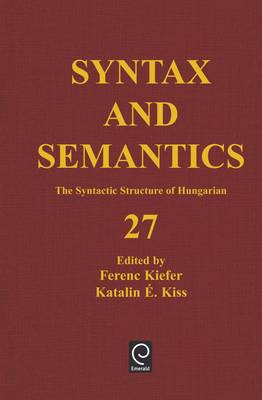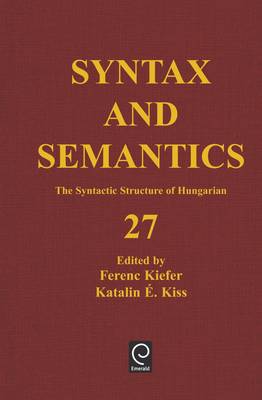
Door een staking bij bpost kan je online bestelling op dit moment iets langer onderweg zijn dan voorzien. Dringend iets nodig? Onze winkels ontvangen jou met open armen!
- Afhalen na 1 uur in een winkel met voorraad
- Gratis thuislevering in België vanaf € 30
- Ruim aanbod met 7 miljoen producten
Door een staking bij bpost kan je online bestelling op dit moment iets langer onderweg zijn dan voorzien. Dringend iets nodig? Onze winkels ontvangen jou met open armen!
- Afhalen na 1 uur in een winkel met voorraad
- Gratis thuislevering in België vanaf € 30
- Ruim aanbod met 7 miljoen producten
Zoeken
The Syntactic Structure of Hungarian
€ 187,95
+ 375 punten
Omschrijving
Hungarian syntax has played a vital, albeit much debated role in linguistic theory since the early 1980s. Volume 27 of "Syntax and Semantics" is the result of a project on Hungarian syntax launched in the early 1980s at the Research Institute for Linguistics of the Hungarian Academy of Sciences. The volume illuminates relevant and insightful aspects of Hungarian syntax. It assumes the basic theoretical claims and the basic methodology of generative linguistic theory, and shows that descriptive grammar is best approached by posing theoretically interesting questions. It features comprehensive coverage of Hungarian syntax and presents a complete analysis of salient questions and theories. It offers new insights into Hungarian syntax and discusses the important role Hungarian syntax has played in linguistic theory throughout the past decade.
Specificaties
Betrokkenen
- Uitgeverij:
Inhoud
- Aantal bladzijden:
- 496
- Taal:
- Engels
- Reeks:
- Reeksnummer:
- nr. 27
Eigenschappen
- Productcode (EAN):
- 9780126135275
- Verschijningsdatum:
- 20/06/1994
- Uitvoering:
- Hardcover
- Formaat:
- Genaaid
- Afmetingen:
- 161 mm x 236 mm
- Gewicht:
- 816 g

Alleen bij Standaard Boekhandel
+ 375 punten op je klantenkaart van Standaard Boekhandel
Beoordelingen
We publiceren alleen reviews die voldoen aan de voorwaarden voor reviews. Bekijk onze voorwaarden voor reviews.










